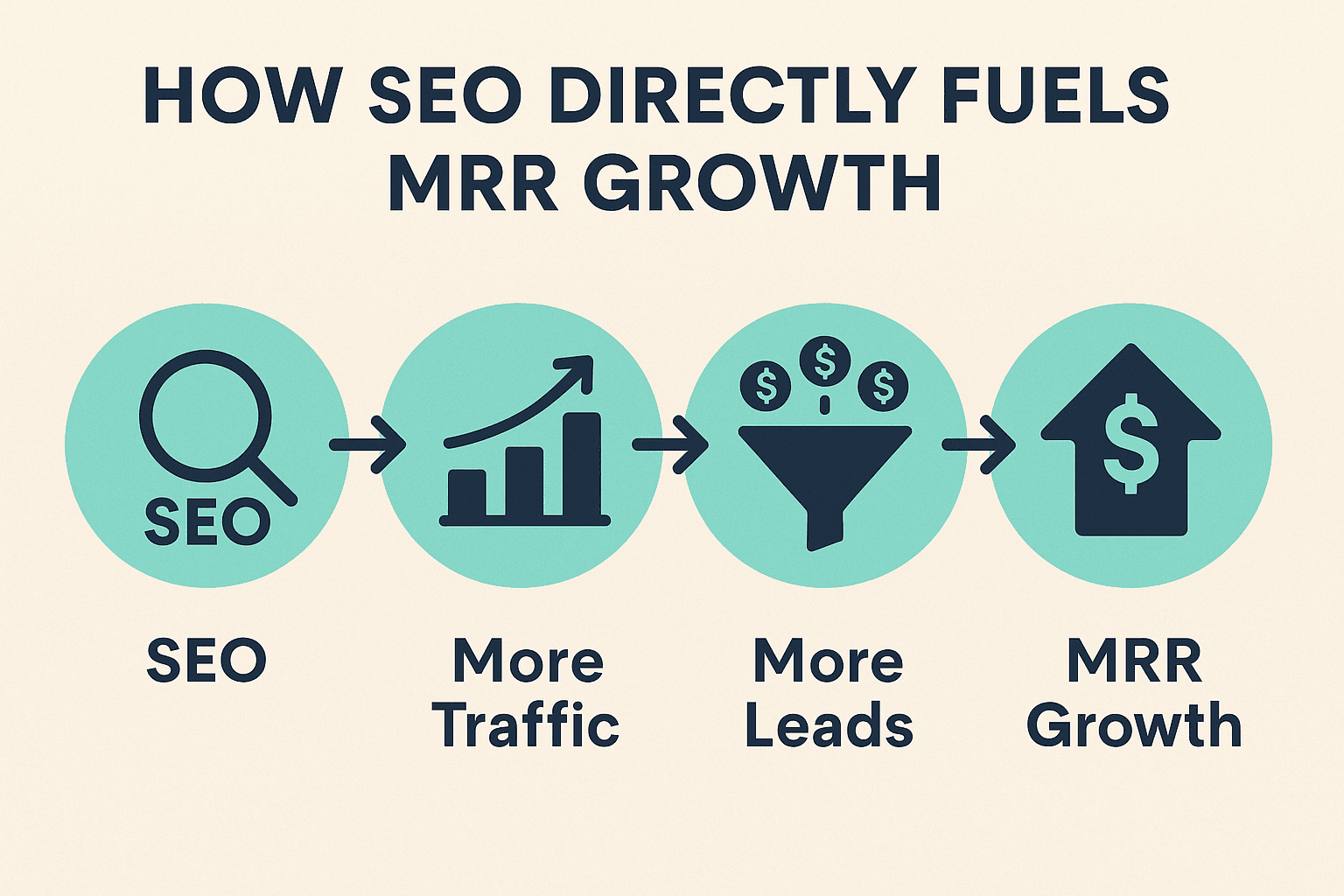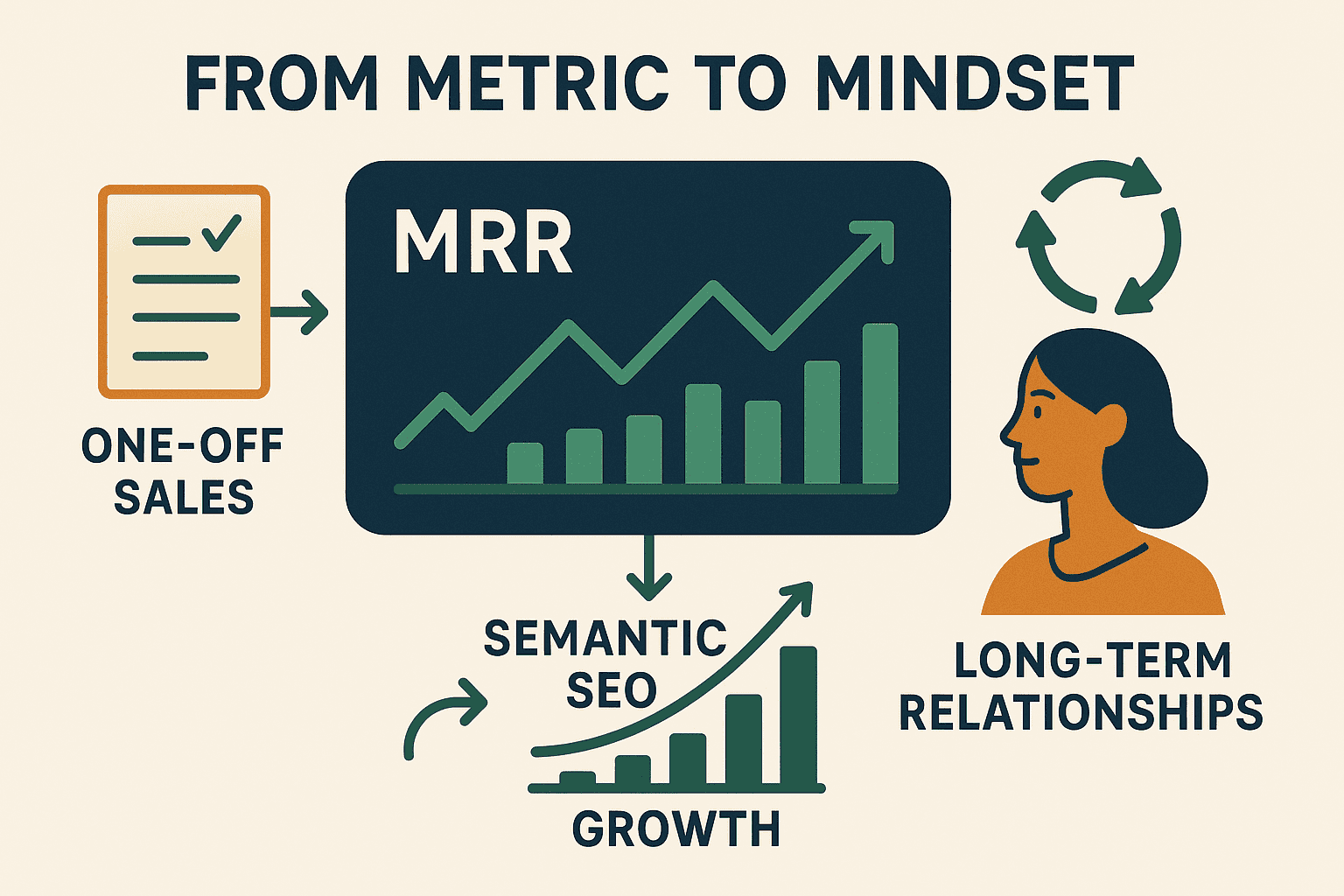
Why MRR is Your Startup’s North Star for Predictable Growth
For any startup founder, the journey is often a rollercoaster of exhilarating highs and gut-wrenching lows. One of the biggest sources of anxiety is unpredictable revenue. How do you plan for hiring, marketing spend, or product development when you don’t know how much cash will be in the bank next month? This is where Monthly Recurring Revenue (MRR) becomes more than just a metric—it becomes your North Star.

In the world of subscription-based businesses, particularly Software-as-a-Service (SaaS), MRR is the heartbeat of your company. It provides the predictability needed to make strategic decisions, build investor confidence, and scale sustainably. But MRR is far more than a simple number; it’s a nuanced indicator of your startup’s health, momentum, and long-term potential.
At Spider Soft, we’ve seen firsthand how a deep understanding of MRR, combined with a powerful SEO strategy for startups, can transform a struggling venture into a market leader. This comprehensive guide will deconstruct MRR for you. We’ll go beyond the basic definition to explore its calculation, the common pitfalls to avoid, and how to leverage advanced SEO frameworks to fuel its growth. Let’s turn your revenue uncertainty into predictable success.
Deconstructing MRR: What is Monthly Recurring Revenue?
Before we can grow it, we must first understand it. Monthly Recurring Revenue is a foundational concept, but its simplicity can be deceptive. A precise understanding is crucial for accurate financial modeling and strategic planning.
What is MRR (Monthly Recurring Revenue)?
Monthly Recurring Revenue (MRR) is the predictable total revenue your business generates each month from all active subscriptions. As defined by Salesforce, it’s a normalized metric that provides a consistent way to track the recurring revenue components of your business over time.
Think of it as the baseline income you can reliably expect to receive every 30 days, barring any changes like cancellations or upgrades. This predictability is what makes the subscription model so powerful for startups.
What’s Included in MRR?
- Recurring Subscription Fees: The core of MRR. This includes all monthly, quarterly, and annual plans, normalized to a monthly value.
- Recurring Add-ons and Upgrades: Any extra features, seats, or services that customers pay for on a recurring monthly basis.
- Discounts: Discounts are factored in. If a customer has a 20% discount on a $100/month plan, their contribution to MRR is $80.
What’s Excluded from MRR?
- One-Time Fees: Setup fees, implementation charges, or consultation fees are not recurring and should be excluded.
- Variable and Usage-Based Fees: Charges based on consumption (e.g., per-API-call fees) that fluctuate month-to-month are not part of MRR.
- Annual Contracts (at full value): A $12,000 annual contract contributes $1,000 to MRR each month, not the full $12,000 in the month it was signed.
- Trial Users: Potential customers on a free trial do not contribute to MRR until they convert to a paid plan.
Why MRR is the North Star Metric for Your Startup
For a subscription-based startup, MRR is arguably the single most important metric. It provides a clear lens through which to view your company’s health and trajectory. Investors, in particular, scrutinize MRR growth as a primary indicator of a startup’s viability and scalability.
- Financial Forecasting and Planning: Predictable revenue allows for accurate budgeting. You can confidently plan for future expenses like hiring new developers, launching a digital marketing campaign, or investing in new infrastructure.
- Performance Measurement and Momentum: MRR growth is a direct measure of your startup’s momentum. Tracking it month-over-month tells you if your strategies are working. A steady increase indicates positive performance, while stagnation or decline signals that something needs to be addressed.
- Investor Confidence and Valuation: As noted in a 2023 report by SaaS Capital, SaaS companies with strong organic channels and steady MRR growth often see higher valuation multipliers. Investors use MRR to gauge the health and stability of a business, making it a critical component of any fundraising pitch.
- Understanding Customer Lifetime Value (CLV): MRR is a key input for calculating CLV, which estimates the total revenue a customer will generate throughout their relationship with your company. This helps you understand how much you can afford to spend on Customer Acquisition Cost (CAC).

The Anatomy of MRR: How to Calculate It Accurately
While the top-level MRR figure is important, the real insights come from breaking it down into its constituent parts. Understanding the “why” behind your MRR changes is what empowers you to make smarter decisions.
The Core MRR Calculation Formula
At its most basic level, the formula for MRR is straightforward. As explained by financial analytics platform Baremetrics, you can calculate it as:
MRR = Number of Active Customers × Average Revenue Per User (ARPU)
For example, if you have 100 customers paying an average of $50 per month:
100 customers × $50/month = $5,000 MRR
This top-level number is a good starting point, but to truly understand your business dynamics, you need to dig deeper.
Beyond the Basics: The 5 Key Types of MRR
Your total MRR is a moving target, influenced by new customers, upgrades, downgrades, and cancellations. Tracking these components separately provides a granular view of your startup’s health.
| Type of MRR | Definition | What It Tells You |
|---|---|---|
| New MRR | The recurring revenue generated from brand new customers acquired in a given month. | The effectiveness of your sales and marketing efforts in attracting new business. |
| Expansion MRR (Upgrade MRR) | The additional recurring revenue from existing customers who upgrade to a higher-priced plan or purchase recurring add-ons. | Your ability to deliver increasing value to your current customer base. This is a powerful, often overlooked, growth lever. |
| Contraction MRR (Downgrade MRR) | The revenue lost from existing customers who downgrade to a lower-priced plan. | Indicates that customers are finding less value or that your pricing tiers may not be perfectly aligned with their needs. |
| Churn MRR | The total revenue lost in a month from customers who cancel their subscriptions entirely. | A critical indicator of customer dissatisfaction, poor product-market fit, or effective competitor strategies. |
| Reactivation MRR | The recurring revenue from former customers who had previously churned but returned to a paid plan. | Shows the effectiveness of your win-back campaigns and the lasting value of your product. |
Calculating Net New MRR: The True Measure of Growth
Net New MRR is the ultimate indicator of your monthly growth. It consolidates all the movements within your customer base into a single, powerful number.
Net New MRR = (New MRR + Expansion MRR + Reactivation MRR) - (Churn MRR + Contraction MRR)
A positive Net New MRR means your business is growing, while a negative value means you’re shrinking. By analyzing each component, you can pinpoint exactly what’s driving your growth or holding you back. For example, high New MRR might be masking an even higher Churn MRR, a dangerous situation known as the “leaky bucket” problem.
Common MRR Calculation Mistakes Startups Must Avoid
According to Paddle, a surprising number of SaaS companies make fundamental errors when calculating MRR. These mistakes can lead to flawed financial models and misinformed strategic decisions. Here are the most common pitfalls:
- Including One-Time Payments: Setup fees, consulting, and other non-recurring charges inflate your MRR and create a false sense of security. They belong in your total revenue, not your recurring revenue.
- Booking Full Annual Contract Value at Once: A $12,000 annual contract adds $1,000 to your MRR for 12 months. Booking the full $12,000 in a single month drastically skews your momentum metrics.
- Counting Trial Users: A user on a free trial is a potential customer, not a paying one. Only include them in MRR once they have converted and their first payment is processed.
- Forgetting to Subtract Discounts: If you offer a customer a 50% discount on a $200/month plan, their contribution to MRR is $100, not $200. Be honest with your numbers.
- Subtracting Transaction Fees or Delinquent Charges: MRR should reflect the agreed-upon subscription value. Transaction fees are an operational expense, and delinquent (failed) payments should be tracked separately as part of your churn analysis.
How SEO Directly Fuels MRR Growth
Understanding and calculating MRR is the first step. The next is actively growing it. While sales efforts and product improvements are crucial, many startups overlook one of the most powerful, long-term engines for MRR growth: Search Engine Optimization (SEO).

SEO as a Growth Multiplier, Not Just a Marketing Tactic
For SaaS founders, it’s time to reframe your thinking. As we’ve detailed in our guide on how SEO helps SaaS startups boost MRR, SEO is not a marketing expense; it’s a long-term growth multiplier that builds a predictable, scalable, and cost-effective customer acquisition channel.
How a Strong SEO Strategy Impacts MRR:
- Lowers Customer Acquisition Cost (CAC): Organic leads from search are significantly cheaper than leads from paid advertising. Gartner research shows organic leads can cost 61% less than outbound leads, directly improving your business’s economics.
- Attracts High-Intent Leads: SEO connects you with users who are actively searching for solutions. Someone Googling “[your competitor] alternative” or “best CRM for small teams” has a high purchase intent, leading to better conversion rates.
- Creates a Predictable Lead Flow: Unlike paid campaigns that stop when the budget runs out, a well-ranking article becomes a long-term asset, delivering consistent traffic and leads for months or even years. This predictability is the foundation of stable MRR growth.
- Builds a Defensible Competitive Advantage: Once you establish domain authority and top rankings, it becomes incredibly difficult and expensive for competitors to displace you. This “moat” gives you a sustainable edge in the market.
A Semantic SEO Framework for Boosting MRR
To truly leverage SEO for MRR growth, startups must move beyond outdated tactics like keyword stuffing. The future of SEO is semantic. Semantic SEO is about optimizing for meaning, context, and the relationships between concepts (or “entities”). This approach helps search engines like Google understand your content’s depth and expertise, rewarding you with higher visibility.
Drawing from advanced methodologies like the **Koray Tuğberk Semantic Framework**, we can build a strategy that establishes your startup as a topical authority, directly driving high-quality traffic that converts into recurring revenue.
Step 1: Build Topical Authority with Pillar-Cluster Content
Instead of writing random blog posts, organize your content into **Topic Clusters**. This model, popularized by HubSpot, involves creating a central “Pillar Page” on a broad topic and linking it to several in-depth “Cluster Pages” that cover specific subtopics.
- Pillar Page: A comprehensive, long-form guide covering a core topic relevant to your startup (e.g., “The Ultimate Guide to Project Management for Remote Teams”).
- Cluster Content: Detailed articles that explore specific subtopics and link back to the pillar page (e.g., “Best Free Gantt Chart Software,” “How to Improve Remote Team Collaboration,” “On-Premise vs. Cloud Project Management”).
This structure signals to Google that you are an authority on the entire topic, not just a single keyword. For a startup, this is the fastest way to build credibility and outrank more established competitors. It’s a core part of the smart SEO strategies we implement for our clients.
Step 2: Master Search Intent with Micro-Semantic Optimization
Every search query has an intent behind it. Is the user looking for information, comparing options, or ready to buy? **Micro-semantics** is the practice of optimizing the smallest units of meaning—words, phrases, and their relationships—to precisely match this intent.
Instead of just targeting a broad keyword like “project management software,” a micro-semantic approach focuses on long-tail, high-intent variations:
- Informational Intent: “what are the key features of project management software”
- Commercial Investigation: “kendo manager vs asana comparison”
- Transactional Intent: “buy self-hosted project management software”
By creating content that perfectly answers these specific queries, you attract users at every stage of the buyer’s journey, guiding them from awareness to conversion and boosting your New MRR.
Step 3: Establish Trust and Authority with E-E-A-T and Link Building
Google’s E-E-A-T framework (Experience, Expertise, Authoritativeness, and Trustworthiness) is central to modern SEO. To rank, you must prove your content is credible and trustworthy. For a startup, this means:
- Showcasing Expertise: Publish in-depth case studies, original research, and expert-written articles. If you’re building a tool like Kendo Manager, write authoritatively about the challenges of project management.
- Building Authoritativeness: Earn high-quality backlinks from reputable sites in your industry. This is a powerful “vote of confidence” that tells Google your site is a trusted resource. A strategic SaaS link-building campaign is essential for growing authority and, consequently, MRR.
- Demonstrating Trustworthiness: Ensure your site is secure (HTTPS), provide clear contact information, and feature customer testimonials and reviews. Trust is the foundation of both high rankings and a low Churn MRR.
FAQ: Top 5 Questions About MRR in a Startup
1. What is a good MRR growth rate for a startup?
A “good” MRR growth rate depends heavily on the startup’s stage. According to a report by Consero Global, early-stage startups (post-seed/pre-Series A) should aim for 15-20% month-over-month growth. As the company matures and the revenue base grows, a rate of 10-15% is considered very strong. The key is to demonstrate consistent, predictable growth rather than sporadic spikes.
2. How is MRR different from ARR (Annual Recurring Revenue)?
MRR and ARR measure the same thing—recurring revenue—but on different time scales. MRR (Monthly Recurring Revenue) provides a short-term, granular view of your business’s health and is ideal for operational planning and tracking monthly momentum. ARR (Annual Recurring Revenue) provides a long-term, high-level perspective. It is calculated simply as ARR = MRR × 12. ARR is the preferred metric for annual forecasting, strategic planning, and conversations with investors about company valuation.
3. Can a startup have negative MRR?
A startup’s total MRR cannot be negative, as it represents revenue from paying customers. However, a startup can have a **negative Net New MRR**. This occurs when the revenue lost from churn and downgrades is greater than the revenue gained from new customers and upgrades in a given month. A negative Net New MRR is a major red flag, indicating that the business is shrinking and needs to urgently address customer retention.
4. Should I focus on New MRR or Expansion MRR?
Both are critical, but their importance shifts as a startup matures. In the very early stages, the primary focus is on acquiring new customers and growing **New MRR** to validate product-market fit. However, as you build a customer base, **Expansion MRR** becomes an incredibly efficient growth engine. It’s often 5-10 times cheaper to upsell an existing customer than to acquire a new one. A healthy SaaS business has a strong balance of both, with Expansion MRR eventually becoming a major contributor to overall growth.
5. How can I build a knowledge base that supports MRR growth?
A well-structured knowledge base is a powerful asset for both customer retention (reducing Churn MRR) and acquisition (increasing New MRR). As outlined by KnowledgeOwl, best practices include creating a clear, hierarchical structure, using multiple content formats (text, video, GIFs), and ensuring it’s easily searchable. From an SEO perspective, your knowledge base is a perfect place to build out topic clusters. By creating helpful, in-depth articles that answer common customer questions, you not only reduce support tickets but also attract organic traffic from users searching for solutions, directly feeding your acquisition funnel.
From Metric to Mindset
For a modern startup, Monthly Recurring Revenue is more than a KPI on a dashboard; it’s a fundamental mindset. It forces you to shift from chasing one-off sales to building long-term customer relationships and delivering continuous value. By mastering the calculation of MRR, you gain clarity. By understanding its components, you gain insight. And by strategically investing in long-term growth engines like semantic SEO, you build a predictable, scalable, and ultimately more valuable business.

The path to sustainable growth is paved with predictable revenue. Make MRR your guide, and you’ll be well on your way to not just surviving, but thriving in the competitive startup landscape. If you’re ready to turn these strategies into results, contact Spider Soft today, and let’s build your digital future together.


